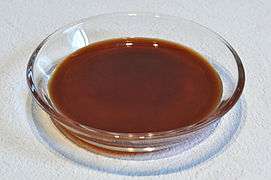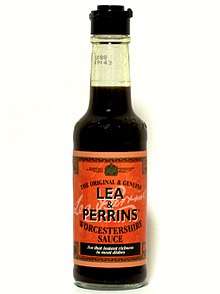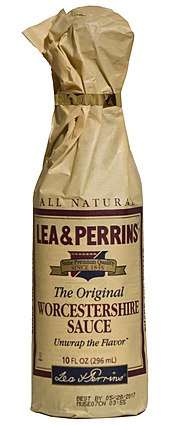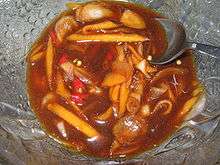Worcestershire sauce

Worcestershire sauce (/ˈwʊstərʃər, ![]()
Worcestershire sauce is frequently used to enhance food and drink recipes, included in traditional Welsh rarebit, Caesar salad, Oysters Kirkpatrick, and deviled eggs. As both background flavour and a source of umami, the savoury so-called "fifth flavour", it is also added to dishes which historically did not contain it, such as chili con carne and beef stew. It is also used directly as a condiment on steaks, hamburgers, and other finished dishes. The sauce is also used to flavour cocktails such as the Bloody Mary and Caesar.[3]
History
A fermented fish sauce called garum was a staple of Greco-Roman cuisine and of the Mediterranean economy of the Roman Empire, as the first-century encyclopaedist Pliny the Elder writes in his Historia Naturalis and the fourth/fifth-century Roman culinary text Apicius includes garum in its recipes. The use of similar fermented anchovy sauces in Europe can be traced back to the 17th century. [4]
Lea & Perrins
 Bottle of Lea & Perrins Worcestershire sauce | |
| Product type | Condiment |
|---|---|
| Produced by | Lea & Perrins HJ Heinz French's Food |
| Country | Worcester, England |
| Introduced | 1837 |
| Previous owners |
|
Product History
The Lea & Perrins brand was commercialised in 1837 and has continued to be the leading global brand of Worcestershire sauce.[5] The origin of the Lea & Perrins recipe is unclear. The packaging originally stated that the sauce came "from the recipe of a nobleman in the county". The company has also claimed that "Lord Marcus Sandys, ex-Governor of Bengal" encountered it while in India with the East India Company in the 1830s, and commissioned the local apothecaries to recreate it.
According to company tradition, when the recipe was first mixed there the resulting product was so strong that it was considered inedible and the barrel was abandoned in the basement. Looking to make space in the storage area a few years later, the chemists decided to try it again, and discovered that the long fermented sauce had mellowed and was now palatable. In 1838 the first bottles of "Lea & Perrins Worcestershire sauce" were released to the general public.[6][7] On 16 October 1897, Lea & Perrins relocated manufacturing of the sauce from their pharmacy to a factory in the city of Worcester on Midland Road, where it is still made. The factory produces ready-mixed bottles for domestic distribution and a concentrate for bottling abroad.[8]
In 1930, the Lea & Perrins operation was purchased by HP Foods, which was in turn acquired by the Imperial Tobacco Company in 1967. HP was sold to Danone in 1988 and then to Heinz in 2005.
Due to a shortages during World War II, Lea and Perrins switched from using soy sauce to hydrolyzed vegetable protein.[2]
US version of Lea and Perrins

The US version is packaged differently from the British version, coming in a dark bottle with a beige label and wrapped in paper. Lea & Perrins USA claims this practice is a vestige of shipping practices from the 19th century, when the product was imported from England, as a measure of protection for the bottles.[9] The producer also claims that its Worcestershire sauce is the oldest commercially bottled condiment in the US.[10]
Ingredients
The original ingredients of bottle of Worcestershire sauce sold were:
- Barley malt vinegar
- Spirit vinegar
- Molasses
- Sugar
- Salt
- Anchovies
- Tamarind extract
- Onions
- Garlic
- Spice
- Flavourings
The "flavourings" are believed to include cloves, soy sauce, lemons, pickles and peppers.[8]
Notes from the 1800s were found dumped in a skip in 2009 by company accountant Brian Keogh. The documents are to be placed on display at the Worcester City Art Gallery & Museum.[8][11]
Anchovies in many Worcestershire sauces is a concern to people allergic to fish,[12] vegans, other vegetarians and others who avoid eating fish. The Codex Alimentarius recommends that prepared food containing Worcestershire sauce with anchovies include a label warning of fish content although this is not required in most jurisdictions. The US Department of Agriculture has forced the recall of some products with undeclared Worcestershire sauce.[13][14] Several brands sell anchovy-free varieties of Worcestershire sauce, often labelled as vegetarian or vegan.[15] Generally,[16] Orthodox Jews refrain from eating fish and meat in the same dish, so cannot use traditional Worcestershire sauce to flavour meat. However, certain brands are certified to contain less than 1/60th of the fish product and can be used with meat.[17][18]
A teaspoon of low-sodium Worcestershire sauce available in the United States has:[19]
- 5 calories
- 0 grams of fat
- 0 grams of protein
- 1 gram of carbohydrates
- 20 milligrams of sodium
- 0 milligrams of cholesterol
Other worcestershire sauces
Denmark
In Denmark, Worcestershire sauce is commonly known as Engelsk sauce, meaning 'English sauce'.[20]
El Salvador
Worcestershire Sauce (known colloquially as La salsa inglesa or La salsa Perrins) is extremely popular in El Salvador, where many restaurants provide a bottle on each table. Over 120,000 gallons is consumed annually, the highest per-capita consumption in the world. [21]
Japan
In Japan, Worcestershire sauce is labelled Worcester (rather than Worcestershire) in katakana. Thicker, Worcestershire sauce-based sauces are manufactured there under brand names such as Otafuku and Bulldog, but these are brown sauces more similar to HP Sauce rather than any type of Worcestershire sauce.
Tonkatsu sauce is a variation of Worcestershire sauce associated with the dish tonkatsu. It is a vegetarian sauce made from vegetables and fruits.[22][23]
Thailand
Gy-NGuang Worcestershire sauce has been produced since 1917.[24]
United Kingdom, Australia, New Zealand
Holbrook's worcestershire has been produced since 1875 but relocated to Australia in the 1950s [25]
United States
French's worcestershire sauce Introduced in 1941 [26]
Heinz Worcestershire Sauce
See also
References
- ↑ Oxford English Dictionary.
- 1 2 "Info" (PDF). www.soyinfocenter.com.
- ↑ "It's 2009, the 40th Anniversary of 'Canada's Drink': The Caesar". That's the Spirit. Archived from the original on 2013-01-20.
- ↑ "Fish Sauce: An Ancient Roman Condiment Rises Again".
- ↑ "Heinz Acquires Leading Sauce Brands, Including Lea & Perrins(R), From Groupe Danone for US$820 Million; Transaction Accelerates Growth in Global Condiments and Sauces". Retrieved 2018-02-24.
- ↑ Keogh, Brian (1997) The Secret Sauce: a History of Lea & Perrins ISBN 978-0-9532169-1-8
- ↑ Shurtleff, William; Aoyagi, Akiko (2012). History of Worcestershire Sauce (1837-2012). Soyinfo Center. ISBN 978-1-928914-43-3.
- 1 2 3 Schlesinger, Fay (3 November 2009). "It's out after 170 years, the secret of Worcestershire Sauce... found in a skip". Daily Mail Online. Retrieved 23 June 2010.
- ↑ About, Lea & Perrins
- ↑ History, Lea & Perrins
- ↑ "Spirit of Enterprise Exhibition – Wine & Sauce Making", Art Gallery & Museum, Worcester City
- ↑ Steinman, HA (August 1996). "'Hidden' allergens in foods". Journal of Allergy and Clinical Immunology. 98 (2). doi:10.1016/s0091-6749(96)70146-x. Retrieved 2014-01-14.
- ↑ Recall, US: DA, 2003
- ↑ Taylor, SL; Kabourek, JL; Hefle, SL (October 2004). "Fish Allergy: Fish and Products Thereof" (PDF). Journal of Food Science. Institute of Food Technologists. 69 (8). doi:10.1111/j.1750-3841.2004.tb18022.x. Retrieved 14 January 2014.
- ↑ Simpson, Alicia C. (2009). Quick and Easy Vegan Comfort Food: Over 150 Great-Tasting, Down-Home Recipes and 65 Everyday Meal Ideas—for Breakfast, Lunch, and Dinner. The Experiment. pp. 13–. ISBN 978-1-61519-109-3.
- ↑ "Ask the Expert: Meat and Fish - My Jewish Learning".
- ↑ Cohen, Dovid. "Fish and Meat". Chicago Rabbinical Council. Retrieved 14 January 2014.
- ↑ "Kosher certification". Star-K. Retrieved 4 July 2009.
- ↑ "Ingredients: Worcestershire Sauce". Dr Gourmet. Retrieved 27 July 2011.
- ↑ "engelsk sauce". Saucer, krydderier og garniture (in Danish). Den store danske.
- ↑ "Salvadorans Relish a Bottle of Worcestershire Sauce - WSJ".
- ↑ "About Tonkatsu". Bull-Dog Sauce Company. Retrieved 2018-04-22.
- ↑ "Western Roots, Japanese Taste: Tonkatsu". Food Forum. Kikkoman. Archived from the original on 2011-04-04.
- ↑ Sauce, Tinnakorn Worcester. "GY-NGUANG Worcester Sauce - Thailand". www.gy-nguang.com.
- ↑ "Let's Look Again". Let's Look Again. 12 October 2015.
- ↑ "Condiments, Sauces, and Recipe Ideas - French's". www.frenchs.com.
External links
| Wikimedia Commons has media related to Worcestershire sauce. |
- Atkinson, Chef Greg (Jan 28, 2001), "Sauce of Legend", The Seattle Times, NW source, archived from the original on 2002-06-08 , abetted by Lea & Perrins, reports and debunks the myth, without unveiling Lady Sandys.
- A very different history of Worcester Sauce, Foods of England .
